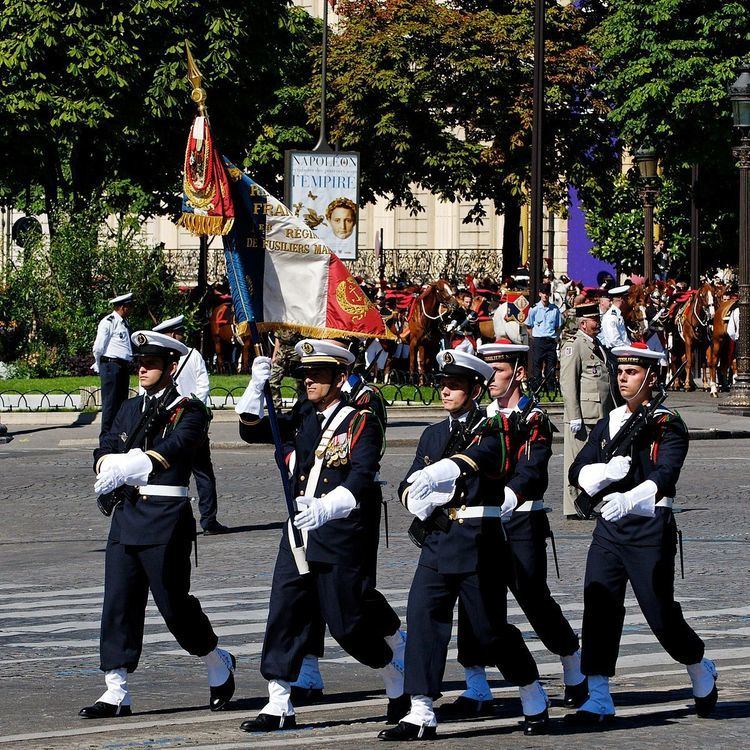 | ||
The Fusiliers Marins ("Naval Fusiliers") are specialized naval infantry trained for combat in land and coastal regions. The Fusiliers Marins are also in charge of providing protection for naval vessels and French Navy key sites on land.
Contents
Missions
The Fusiliers Marins are tasked with :
In size and roles the Fusiliers Marins are hardly comparable to the United States Marine Corps. While the modern designation of French Marine excluding the Foreign Legion equivalent of the U.S.M.C is the Troupes de Marine of the French Army ( In 1890, the ministry of the colonies separated from the Ministère de la Marine. The troops were finally attached in 1900 (by the decreed law of July 7 1900) to the Département de la Guerre and were designated then as Troupes coloniales). The Fusiliers Marins nevertheless, are and remain since founding, the primary naval infantry of the French Navy.
Ancestors, Compagnies Franches de la Marine
In 1627 Cardinal Richelieu undertook the creation of a Naval Regiment, intended to provide soldiers for service on naval ships. Their roles were to include combat on both land or sea, under the orders of the officers of the ship. These sea-going soldiers formed part of the ship's company and helped with its sailing. The basic units were the Compagnies Franches de la Marine: separate detachments of about 70 men, each commanded by a royal lieutenant des vaisseaux, supported by two ensigns. The marine companies served in the French colonies of the period and particularly in Nouvelle-France. These formations existed under differing titles until 1825 when they were dissolved by a royal ordinance decreeing that landing parties (compagnies de débarquement) be made up of sailors. The Régiments de la Marine were subsequently succeeded by the Troupes de la marine, which later became the colonial troops (Troupes Coloniales) of the French Army, specifically raised for overseas service.
Creation of a specialized corps in 1856
These companies lacked specialized personnel trained for combat on land.
An Imperial decree dated June 5 1856, created the Fusiliers Marins, whose formation and training were undertaken by a battalion stationed at Lorient. This specialized corps was put under the command of the captains and sergeants-at-arms of the various naval vessels of the Fleet was the direct ancestor of the modern Fusiliers Marins.
Since that date, the Fusiliers Marins have participated the following conflicts:
During the Franco-Prussian War 1870, following the disaster of Sedan, several brigades of Fusiliers Marins and artillerymen were combat engaged at Bapaume and engaged in defending Paris at the Bourget and at L'Haÿ-les-Roses notably. During the Paris Commune in 1871, the regiment participated with armée versaillaise.
In 1900, the fusiliers marins participated to the protection of the legation in China during the Boxer Rebellion. Among their officers was enseigne de vaisseau Paul Henry and Pierre Alexis Ronarc'h, who a couple of years later, would be promoted Counter-Admiral and Commandant of the Brigade de Fusiliers Marins BFM in 1914 attached to the 32nd Army Corps. It was in 1914 at the beginning of the first world war, that the Brigade de Fusiliers Marins wrote in witnessing their historical page. Their determined participation to the combats at Dixmude, on the Yser, at Longewaede, Hailles and Laffaux, marked their esprit de corps.
The Fusiliers Marins have also participated to the campaigns of Free France. They formed first a battalion then the 1er Régiment de Fusiliers Marins 1e RFM at the corps of the 1st Free French Division (1er DFL) and the 1er Bataillon de Fusiliers Marins Commandos (1er BFMC) who served in 10 (Inter-Allied) Commando. The 177 Commandos Kieffer whom disembarked on June 6 in Normandy, were Fusiliers Marins issued in principal by Free France. Other Fusiliers Marins, issued in principal from the Army of Vichy (French: Armée de Vichy), formed the Régiment Blindé de Fusiliers-Marins (RBFM) which illustrated capability with the 2nd Armored Division. Adding to the list of accessories, on April 30 1945, the Fusiliers Marins Dupin of Saint-Cyr contributed to the liberation of île d’Oléron. Disembarked at 0620 at Gatseau, the troop progressed slowly in the forest facing a stern resistance.
In 1945, the Marine Brigade of the Extreme Orient (BMEO) was created with the RBFM and the 1er RFM. Based on the request of general Leclerc, the Marine Brigade formed river brigades in 1945-1946. They became the Dinassaut which operated in Tonkin and Cochinchina from 1947 to 1954. In 1956, with the cadres of operations in Algeria, was formed a Demi-Brigade of Fusiliers Marins (DBFM) in charge of protecting the borders between Algeria and Morocco until 1962. This demi-brigade was placed under the command of CV Ponchardier. A flag was conferred upon him.
Contrary to the French Fusiliers Marins which are a specialty of the French Navy, the United States Marine Corps is an independent corps with exclusive own Marine Aviation, Marine Tank, Marine Artillery with respective naval ships attached to the United States Navy. The same applies to the Royal Marines of the Royal Navy.
Uniforms
The Naval Fusiliers wear a dark blue beret in their combat dress uniforms, pulled right with their own distinctive badge worn over the left eye or temple. Along with the Naval Commandos, they are unique among French forces in wearing the beret this way. When wearing regular dress uniforms, the sailor cap is used by junior ratings and the peaked cap by senior petty officers and officers.
Weapons used
Assault Rifles
Sniper Rifles
Shotguns
Pistols
Non-lethal
Machine Guns
Rocket Launchers
